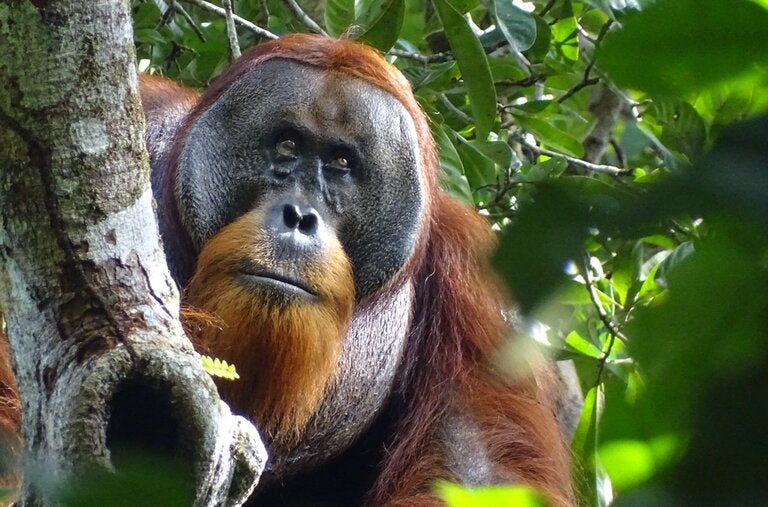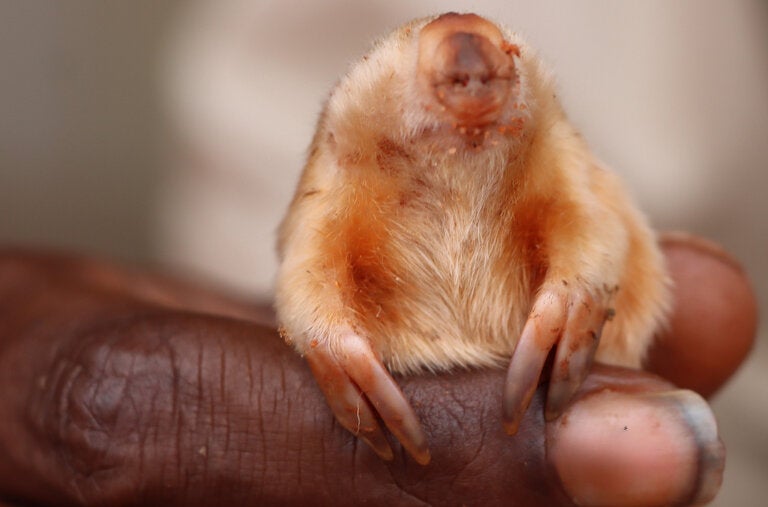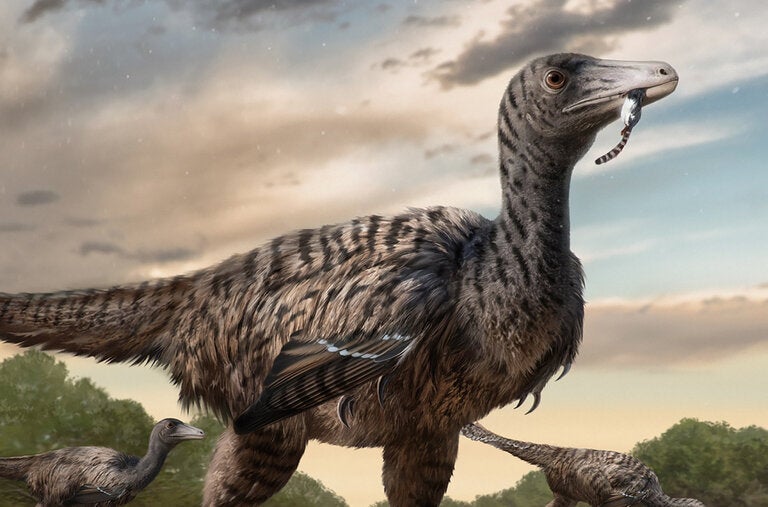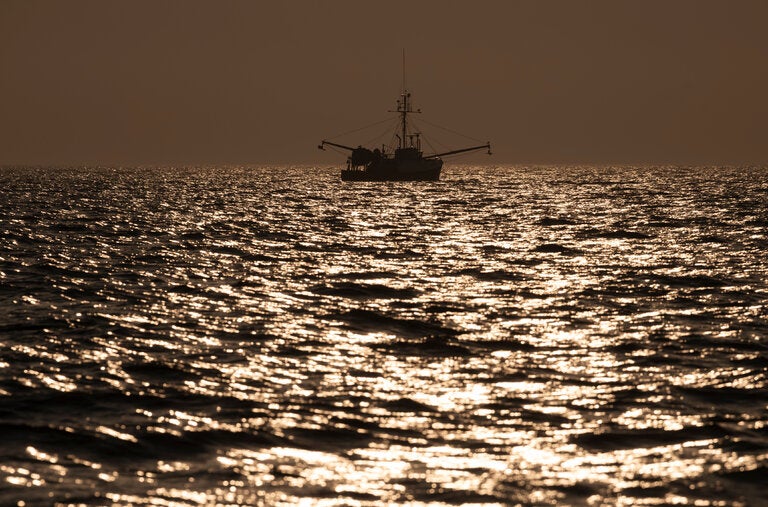Was the Stone Age Actually the Wood Age?
Neanderthals were even better craftsmen than thought, a new analysis of 300,000-year-old wooden tools has revealed.
By

Neanderthals were even better craftsmen than thought, a new analysis of 300,000-year-old wooden tools has revealed.
By

The event will be active when the moon is just a sliver in the sky, but it is less easy to see in the Northern Hemisphere than other meteor showers.
By

Could a better understanding of how infants acquire language help us build smarter A.I. models?
By

Brood XIII and Brood XIX are making their first dual appearance since 1803.
By

China Launches Spacecraft to the Far Side of the Moon
If successful, the Chang’e-6 mission will be the first in history to return a sample from a part of the moon that we never get to see from Earth.
By

For the first time, scientists observed a primate in the wild treating a wound with a plant that has medicinal properties.
By

Republicans Step Up Attacks on Scientist at Heart of Lab Leak Theory
A heated hearing produced no new evidence that Peter Daszak or his nonprofit, EcoHealth Alliance, were implicated in the Covid outbreak.
By

Edward Dwight Aims for Space at Last
Six decades ago, Mr. Dwight’s shot at becoming the first Black astronaut in space was thwarted by racism and politics. Now, at 90, he’s finally going up.
By

Honeybees Invaded My House, and No One Would Help
Responding to fears of a “honeybee collapse,” 30 states have passed laws to protect the pollinators. But when they invaded my house, I learned that the honeybees didn’t need saving.
By

Advertisement

Swimming Beneath Sand, It’s ‘the Hardest of All Animals to Find’
Indigenous rangers in Australia’s Western Desert got a rare close-up with the northern marsupial mole, which is tiny, light-colored and blind, and almost never comes to the surface.
By

A Megaraptor Emerges From Footprint Fossils
A series of foot tracks in southeastern China points to the discovery of a giant velociraptor relative, paleontologists suggest in a new study.
By

In Coral Fossils, Searching for the First Glow of Bioluminescence
A new study resets the timing for the emergence of bioluminescence back to millions of years earlier than previously thought.
By

Like Moths to a Flame? We May Need a New Phrase.
Over time researchers have found fewer of the insects turning up in light traps, suggesting they may be less attracted to some kinds of light than they once were.
By

What Makes a Society More Resilient? Frequent Hardship.
Comparing 30,000 years of human history, researchers found that surviving famine, war or climate change helps groups recover more quickly from future shocks.
By

¿Por qué las mujeres padecen más enfermedades autoinmunes? Un estudio apunta al cromosoma X
Las moléculas que se adhieren al segundo cromosoma X de las mujeres lo silencian y pueden confundir al sistema inmunitario, según un nuevo estudio.
By

Fossil Trove From 74,000 Years Ago Points to Remarkably Adaptive Humans
An archaeological site in Ethiopia revealed the oldest-known arrowheads and the remnants of a major volcanic eruption.
By

Why Do Whales Go Through Menopause?
A new study argues that the change brought these females an evolutionary advantage — and perhaps did the same for humans.
By

Tras la pista de los denisovanos
El ADN ha demostrado que esos humanos ya extintos se extendieron por todo el mundo, desde la fría Siberia hasta el Tíbet, a una gran altitud, quizá incluso en las islas del Pacífico.
By

Advertisement
What Happens When NASA Loses Eyes on Earth? We’re About to Find Out.
Three long-running satellites will soon be switched off, forcing scientists to figure out how to adjust their views of our changing planet.
By

‘We Will Save Our Beef’: Florida Bans Lab-Grown Meat
Other states have also considered restrictions, citing concerns about farmers’ livelihoods and food safety, though the product isn’t expected to be widely available for years.
By

Gas Stove Pollution Risk Is Greatest in Smaller Homes, Study Finds
Gas-burning ranges, a significant contributor to indoor pollution, can produce and spread particularly high levels of some pollutants in smaller spaces.
By

Can Forests Be More Profitable Than Beef?
Cattle ranches have ruled the Amazon for decades. Now, new companies are selling something else: the ability of trees to lock away planet-warming carbon.
By Manuela Andreoni and

U.S. Plan to Protect Oceans Has a Problem, Some Say: Too Much Fishing
An effort to protect 30 percent of land and waters would count some commercial fishing zones as conserved areas.
By


New research finds that the death rate among Black youths soared by 37 percent, and among Native American youths by 22 percent, between 2014 and 2020, compared with less than 5 percent for white youths.
By Emily Baumgaertner

Two periodical cicada broods are appearing in a 16-state area in the Midwest and Southeast for the first time in centuries.
By Aaron Byrd, Karen Hanley and Carl Zimmer

Illinois is the center of the cicada emergence that is on the way. Two groups of cicadas are expected at once, leaving some people queasy, others thrilled.
By Julie Bosman and Jamie Kelter Davis

A genetic analysis sheds light on when the outbreak began, how the virus spread and where it may be going.
By Apoorva Mandavilli and Emily Anthes

The Chang’e-6 mission aims to bring back samples from the lunar far side.
By CCTV via Associated Press

Thousands of Americans believe they experienced rare but serious side effects. But confirming a link is a difficult task.
By Apoorva Mandavilli

All vaccines have at least occasional side effects. But people who say they were injured by Covid vaccines believe their cases have been ignored.
By Apoorva Mandavilli

Professor Young’s experiments with prairie voles revealed what poets never could: how the brain processes that fluttering feeling in the heart.
By Michael S. Rosenwald

But the scope of the outbreak among cattle remains uncertain, and little human testing has been done.
By Noah Weiland and Linda Qiu

Several lawmakers questioned whether the company had become so large — with tentacles in every aspect of the nation’s medical care — that the effects of the hack were outsize.
By Reed Abelson and Noah Weiland

Women at risk for extreme high blood pressure should take a daily baby aspirin. But their doctors don’t always tell them.
By Roni Caryn Rabin

The low water levels that choked cargo traffic were more closely tied to the natural climate cycle than to human-caused warming, a team of scientists has concluded.
By Raymond Zhong

He figured in the examination of sensational cases involving President John F. Kennedy, Martin Luther King Jr., O.J. Simpson and others.
By Trip Gabriel

The Biden administration is tightening efficiency rules for water heaters, stoves and other appliances, and conservative politicians are dialing up their criticisms.
By Hiroko Tabuchi
Advertisement

Some researchers said the advice did not go far enough. The panel also declined to recommend extra scans for women with dense breast tissue.
By Roni Caryn Rabin

With the help of Google Cloud, scientists churned through hundreds of thousands of images of the night sky to reveal that the solar system is filled with unseen objects.
By Kenneth Chang

Around the world, grass-roots organizers and Indigenous communities are taking proposed coal, oil and gas projects to court — and winning.
By Delger Erdenesanaa

Thousands of people with sleep apnea and other illnesses had sued the company, claiming flawed devices were harming them.
By Christina Jewett

A new study bolsters existing research suggesting that exercise can protect against anxiety, depression and attention challenges.
By Matt Richtel

An audacious federal plan to protect the spotted owl would eradicate hundreds of thousands of barred owls in the coming years.
By Franz Lidz

Despite an arsenal of drugs, many Americans are still unaware of their infections until it’s too late. A Biden initiative languishes without Congressional approval.
By Ted Alcorn

The Cleveland Museum of Natural History is rolling out two new exhibition halls and making its scientists more accessible. And don’t forget the dinosaurs.
By John Hanc

The early results suggest that pasteurization is killing the H5N1 virus in milk, something that regulators were not certain of.
By Noah Weiland and Benjamin Mueller

The proposal had been years in the making, in an effort to curb death rates of Black smokers targeted by Big Tobacco. In an election year, the president’s worries about support among Black voters may have influenced the postponement.
By Christina Jewett and Noah Weiland
Advertisement

The women underwent the cosmetic procedure at an unlicensed spa in New Mexico.
By Roni Caryn Rabin

The statue will be part of “Ancient Huasteca Women: Goddesses, Warriors and Governors” at the National Museum of Mexican Art in Chicago.
By Zoë Lescaze

The Atomic Museum in Las Vegas explains to visitors that Nevada and other states also played a role — for better or worse — in the creation of nuclear energy.
By Michael Janofsky

A historian and sociologist of science re-examines the “posture panic” of the last century. You’ll want to sit down for this.
By Matt Richtel

Two creatures unearthed in 2006, and finally on display in North Carolina, might hold the key to a major debate over a certain animal’s identity.
By Adam Popescu

There is no evidence that the milk is unsafe to drink, scientists say. But the survey result strongly hints that the outbreak may be widespread.
By Emily Anthes and Noah Weiland

Of the 160 whales stranded near the town of Dunsborough on Thursday morning, more than 100 were returned to the ocean. Twenty-nine others, however, died on the beach.
By Johnny Diaz

The administration issued a major climate regulation aimed at virtually eliminating carbon emissions from coal, the dirtiest of the fossil fuels and a driver of global warming.
By Coral Davenport and Lisa Friedman

The Biden administration has expressed growing alarm that efforts to fight climate change could falter unless the electric grids are quickly expanded.
By Brad Plumer

Pivmecillinam, which has been used in Europe for decades, will become available next year to women 18 and older.
By Andrew Jacobs
Advertisement

The court’s ruling could extend to at least half a dozen other states that have similarly restrictive bans, and the implications of the case could stretch beyond abortion.
By Pam Belluck

Since a new form of bird flu arrived in 2022, federal officials have sought to reassure Americans that the threat to the public remained low.
By Noah Weiland, Benjamin Mueller and Emily Anthes

NYU Langone Health surgeons performed the transplant after implanting a mechanical heart pump in the severely ill patient.
By Roni Caryn Rabin

Scientists are making computer models to better understand how the mysterious insects emerge collectively after more than a decade underground.
By Carl Zimmer

A single spillover, from a bird to a cow, led to the infections, a review of genetic data has found.
By Apoorva Mandavilli

A show at the New York Botanical Garden, inspired by Lewis Carroll’s books, will explore his fictional and real worlds through plants, art and artifacts.
By Laurel Graeber

The milk poses virtually no risk to consumers, experts said. But the finding suggests that the outbreak in dairy cows is wider than has been known.
By Emily Anthes, Apoorva Mandavilli and Noah Weiland

A 40-year-old man was acquitted of a drunken driving offense after doctors confirmed he had a rare condition: auto-brewery syndrome.
By Ali Watkins

Animal-welfare science tries to get inside the minds of a huge range of species — in order to help improve their lives.
By Bill Wasik and Monica Murphy

Some states with Republican-controlled legislatures want more data, while some controlled by Democrats want less, fearing it could be used to target patients or providers.
By Pam Belluck and Emma G. Fitzsimmons
Advertisement

New research questions the long-held theory that reintroduction of such a predator caused a trophic cascade, spawning renewal of vegetation and spurring biodiversity.
By Jim Robbins

Paris is becoming a city of bikes. Across China, people are snapping up $5,000 electric cars. On Earth Day, a look at a few bright spots for emission reductions.
By Delger Erdenesanaa

They were distinct people who pursued different lives. “Get past this already, everybody,” Lori said, “get past it and learn to know the individual person.”
By Richard Sandomir

H5N1, an avian flu virus, has killed tens of thousands of marine mammals, and infiltrated American livestock for the first time. Scientists are working quickly to assess how it is evolving and how much of a risk it poses to humans.
By Apoorva Mandavilli and Emily Anthes

There’s 50 percent more carbon dioxide in the air than before the Industrial Revolution.
By Aatish Bhatia

Homeownership is not the boon to older Americans that it once was.
By Paula Span

Some poultry growers are turning to innovative tactics to protect their flocks, deploying deterrents like drones, air horns, balloons and decoy predators.
By Linda Qiu

Officials have shared little information, saying the outbreak was limited. But asymptomatic cows in North Carolina have changed the assessment.
By Apoorva Mandavilli and Emily Anthes

Despite significant progress, Scotland was falling short on cutting vehicle emissions, switching to heat pumps and even restoring peatland, the government said.
By Somini Sengupta

A nearly full moon could interfere with the shower during its peak. It is forecast to be active until near the end of the month.
By Katrina Miller
Advertisement

Among those with substance use disorders who have been referred to child welfare, less than half received medication or counseling.
By Emily Baumgaertner

Mammography can miss tumors in women with dense breasts, so their doctors often include ultrasound or M.R.I. scans. Patients often wind up paying the bill.
By Roni Caryn Rabin

A new map of the center of the Milky Way galaxy reveals details of its magnetic fields
By Dennis Overbye

As record heat enveloped the nation, the rate of emergency room visits increased compared with the previous five years, a sign of the major health risks of high temperatures.
By Noah Weiland

An international team of researchers found that heavy rains had intensified in the region, though they couldn’t say for sure how much climate change was responsible.
By Raymond Zhong

Development and groundwater pumping are causing land subsidence and heightening the risks of sea level rise.
By Delger Erdenesanaa

The measure elevates conservation in a number of ways, including by creating new leases for the restoration of degraded areas.
By Catrin Einhorn

The change followed a sweeping review by England’s National Health Service that found “remarkably weak” evidence for youth gender treatments.
By Azeen Ghorayshi

The company has told countries that it can supply only 18.8 million of the 29.6 million doses it was contracted to deliver this year.
By Stephanie Nolen

After a drawn-out global controversy over the coronavirus, the W.H.O. has updated its classification of how pathogens spread through the air.
By Carl Zimmer
Advertisement

The disaster, intensified by El Niño, is devastating communities across several countries, killing crops and livestock and sending food prices soaring.
By Somini Sengupta and Manuela Andreoni

To lure visitors, residents of Yoshida, famed for its high-quality steel, are inviting tourists to help produce it.
By Craig Mod

She was believed to be the first Western scientist to study the animals in their natural habitat, but she struggled to overcome sexism in academia.
By Clay Risen

In a first, a Colorado law extends privacy rights to the neural data increasingly coveted by technology companies.
By Jonathan Moens

Ancient humans left behind numerous archaeological traces in the cavern, and scientists say there may be thousands more like it on the Arabian Peninsula to study.
By Robin George Andrews

When Ruby Reynolds and her father found a fossil on an English beach, they didn’t know it belonged to an 82-foot ichthyosaur that swam during the days of the dinosaurs.
By Kate Golembiewski

New regimens in development, including once-weekly pills and semiannual shots, could help control the virus in hard-to-reach populations.
By Apoorva Mandavilli

The company reported results of clinical trials involving Zepbound, an obesity drug in the same class as Novo Nordisk’s Wegovy.
By Gina Kolata

A mining company wants to build a 211-mile industrial road through Alaskan wilderness to reach a large copper deposit. The Interior Department says it would harm wildlife and communities.
By Lisa Friedman

Soon, this devil-horned comet won’t be visible for another seven decades.
By Katrina Miller
Advertisement

Feral cats take a heavy toll on the world’s wildlife, especially Down Under. The solution? Smarter traps, sharpshooters, survival camp for prey species, and the “Felixer.”
By Emily Anthes and Chang W. Lee

The agency will seek new ideas for its Mars Sample Return program, expected to be billions of dollars over budget and years behind schedule.
By Kenneth Chang

He arranged for artists to have access to astronauts, launchpads and more. “Their imaginations enable them to venture beyond a scientific explanation,” he once said.
By Richard Sandomir

An ascending jet’s contrail over Montreal added to the wonder of last Monday’s eclipse.
By Chloe Rose Stuart-Ulin

His testimony as an expert witness in some 600 trials helped plaintiffs win billions of dollars in cases involving malfeasance by pharmaceutical makers.
By Clay Risen

Mr. Gore spoke at a climate leadership conference hosted by his nonprofit organization.
By Cara Buckley

Rising sea temperatures around the planet have caused a bleaching event that is expected to be the most extensive on record.
By Catrin Einhorn

First, fish off the Florida Keys started swimming in spirals or upside down. Then, endangered sawfish started dying. Scientists are racing to figure out why.
By Patricia Mazzei

Lawmakers raising national security concerns and seeking to disconnect a major Chinese firm from U.S. pharmaceutical interests have rattled the biotech industry. The firm is deeply involved in development and manufacturing of crucial therapies for cancer, cystic fibrosis, H.I.V. and other illnesses.
By Christina Jewett

To protect Australia’s iconic animals, scientists are experimenting with vaccine implants, probiotics, tree-planting drones and solar-powered tracking tags.
By Emily Anthes and Chang W. Lee
Advertisement

When traditional conservation fails, science is using “assisted evolution” to give vulnerable wildlife a chance.
By Emily Anthes and Chang W. Lee

From airlines to pork sellers, corporate brands face legal and regulatory challenges for misleading the public with lofty climate claims.
By Somini Sengupta

He diagnosed dozens of patients with what he said were suppressed memories of being tortured by cults. He later lost his license.
By Clay Risen

For the first time since 1920, the government has raised the rates that companies pay. The fossil fuel industry says it will hurt the economy.
By Coral Davenport

Millions in Sackler donations sat dormant, rising in value as the opioid epidemic raged and as other institutions distanced themselves from the makers of a notorious painkiller.
By Christina Jewett

New research finds that the microscopic “water bears" are remarkably good at repairing their DNA after a huge blast of radiation.
By Carl Zimmer
Advertisement
Advertisement